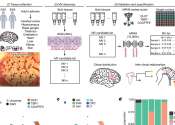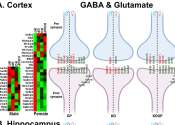The cerebral cortex is a structure within the brain that plays a key role in memory, attention, perceptual awareness, thought, language, and consciousness. It constitutes the outermost layer of the cerebrum. In preserved brains, it has a grey color, hence the name "grey matter". Grey matter is formed by neurons and their unmyelinated fibers, whereas the white matter below the grey matter of the cortex is formed predominantly by myelinated axons interconnecting different regions of the central nervous system. The human cerebral cortex is 2–4 mm (0.08–0.16 inches) thick.
The surface of the cerebral cortex is folded in large mammals, such that more than two-thirds of the cortical surface is buried in the grooves, called "sulci." The phylogenetically most recent part of the cerebral cortex, the neocortex, also called isocortex, is differentiated into six horizontal layers; the more ancient part of the cerebral cortex, the hippocampus (also called archicortex), has at most three cellular layers, and is divided into subfields. Relative variations in thickness or cell type (among other parameters) allow us to distinguish between different neocortical architectonic fields. The geometry of at least some of these fields seems to be related to the anatomy of the cortical folds, and, for example, layers in the upper part of the cortical ridges (called gyri) seem to be more clearly differentiated than in its deeper parts.









